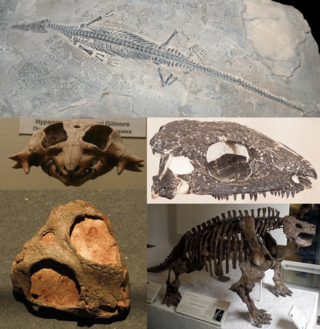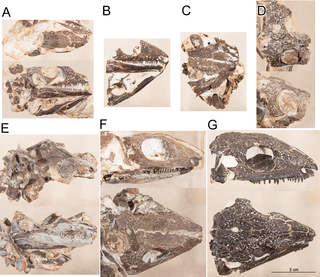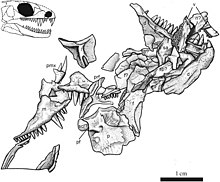
Secodontosaurus is an extinct genus of "pelycosaur" synapsids that lived from between about 285 to 272 million years ago during the Early Permian. Like the well known Dimetrodon, Secodontosaurus is a carnivorous member of the Eupelycosauria family Sphenacodontidae and has a similar tall dorsal sail. However, its skull is long, low, and narrow, with slender jaws that have teeth that are very similar in size and shape—unlike the shorter, deep skull of Dimetrodon, which has large, prominent canine-like teeth in front and smaller slicing teeth further back in its jaws. Its unusual long, narrow jaws suggest that Secodontosaurus may have been specialized for catching fish or for hunting prey that lived or hid in burrows or crevices. Although no complete skeletons are currently known, Secodontosaurus likely ranged from about 2 to 2.7 metres (7–9 ft) in length, weighing up to 110 kilograms (250 lb).

Parareptilia ("near-reptiles") is a subclass or clade of basal sauropsids/reptiles, typically considered the sister taxon to Eureptilia. Parareptiles first arose near the end of the Carboniferous period and achieved their highest diversity during the Permian period. Several ecological innovations were first accomplished by parareptiles among reptiles. These include the first reptiles to return to marine ecosystems (mesosaurs), the first bipedal reptiles, the first reptiles with advanced hearing systems, and the first large herbivorous reptiles. The only parareptiles to survive into the Triassic period were the procolophonoids, a group of small generalists, omnivores, and herbivores. The largest family of procolophonoids, the procolophonids, rediversified in the Triassic, but subsequently declined and became extinct by the end of the period.

Paleothyris was a small, agile, anapsid romeriidan reptile which lived in the Middle Pennsylvanian epoch in Nova Scotia. Paleothyris had sharp teeth and large eyes, meaning that it was likely a nocturnal hunter. It was about a foot long. It probably fed on insects and other smaller animals found on the floor of its forest home. Paleothyris was an early sauropsid, yet it still had some features that were more primitive, more labyrinthodont-like than reptile-like, especially its skull, which lacked fenestrae, holes found in the skulls of most modern reptiles and mammals.

Dendrerpeton is a genus of an extinct group of temnospondyl amphibians. Its fossils have been found primarily in the Joggins Formation of Eastern Canada and in Ireland. It lived during the Carboniferous and is said to be around 309–316 million years of age, corresponding to more specifically the Westphalian (stage) age. Of terrestrial temnospondyl amphibians evolution, it represents the first stage. Although multiple species have been proposed, the species unanimously recognized is D. acadianum. This species name comes from “Acadia” which is a historical name for the Nova Scotia region as a French colony. It refers to the location of the coal field at which the fossil was found.

Anthracosaurus is an extinct genus of embolomere, a possible distant relative of reptiles that lived during the Late Carboniferous in what is now Scotland, England, and Ohio. It was a large, aquatic eel-like predator. It has a robust skull about 40 centimetres (1.3 ft) in length with large teeth in the jaws and on the roof of the mouth. Anthracosaurus probably inhabited swamps, rivers and lakes. Its name is Greek for "coal lizard".

Macroleter is an extinct genus of nycteroleterid parareptile which existed in Oklahoma and Russia during the upper Permian period. It was a quite generalized primitive reptile, in many ways resembling their amphibian ancestors. It was first named by paleontologists Tverdochlebova and Ivachnenko in 1984. According to classification by Michel Laurin and Robert R. Reisz, the genus is a parareptile, belonging to the same branch as Millerettidae, Procolophonidae and other generalized anapsid reptiles. The type species is Macroleter poezicus from Upper Permian of Russia.

Megalocephalus is an extinct genus of baphetid amphibian from the late Carboniferous of the British Isles and the United States (Ohio). It contains two species, M. pachycephalus and M. lineolatus.

The Allegheny Group, often termed the Allegheny Formation, is a Pennsylvanian-age geological unit in the Appalachian Plateau. It is a major coal-bearing unit in the eastern United States, extending through western and central Pennsylvania, western Maryland and West Virginia, and southeastern Ohio. Fossils of fishes such as Bandringa are known from the Kittaning Formation, which is part of the Allegheny Group.

Neopteroplax is an extinct genus of eogyrinid embolomere closely related to European genera such as Eogyrinus and Pteroplax. Members of this genus were among the largest embolomeres in North America. Neopteroplax is primarily known from a large skull found in Ohio, although fragmentary embolomere fossils from Texas and New Mexico have also been tentatively referred to the genus. Despite its similarities to specific European embolomeres, it can be distinguished from them due to a small number of skull and jaw features, most notably a lower surangular at the upper rear portion of the lower jaw.

Odonterpeton is an extinct genus of "microsaur" from the Late Carboniferous of Ohio, containing the lone species Odonterpeton triangulare. It is known from a single partial skeleton preserving the skull, forelimbs, and the front part of the torso. The specimen was found in the abandoned Diamond Coal Mine of Linton, Ohio, a fossiliferous coal deposit dated to the late Moscovian stage, about 310 million years ago.

Delorhynchus is an extinct genus of lanthanosuchoid parareptile known from the late Early Permian Garber Formation of Comanche County, Oklahoma. It contains three species: the type species D. priscus is based on a series of maxillae. The second species to be described, D. cifellii, is known from a larger number of well-preserved skulls and skeletal material. The third species, D. multidentatus, is based on a fragmentary skull with several rows of teeth on its jaw.

Acleistorhinidae is an extinct family of Late Carboniferous and Early Permian-aged parareptiles. Acleistorhinids are most diverse from the Richards Spur locality of the Early Permian of Oklahoma. Richards Spur acleistorhinids include Acleistorhinus, Colobomycter, and possibly Delorhynchus and Feeserpeton. Other taxa include Carbonodraco from the Late Carboniferous of Ohio and Karutia from the Early Permian of Brazil. Acleistorhinidae is commonly considered a subgroup of lanthanosuchoids, related to taxa such as Chalcosaurus, Lanthaniscus and Lanthanosuchus. However, a re-examination of parareptile phylogeny conducted by Cisneros et al. (2021) argued that lanthanosuchids were not closely related to acleistorhinids. The phylogenetic analysis conducted by these authors recovered acleistorhinids as the sister group of the clade Procolophonia, while lanthanosuchids were recovered within the procolophonian subgroup Pareiasauromorpha.

Acleistorhinus (ah-kles-toe-RYE-nuss) is an extinct genus of parareptile known from the Early Permian of Oklahoma. It is notable for being the earliest known anapsid reptile yet discovered. The morphology of the lower temporal fenestra of the skull of Acleistorhinus bears a superficial resemblance to that seen in early synapsids, a result of convergent evolution. Only a single species, A. pteroticus, is known, and it is classified in the Family Acleistorhinidae, along with Colobomycter.

Microleter is an extinct genus of basal procolophonomorph parareptiles which lived in Oklahoma during the Early Permian period. The type and only known species is Microleter mckinzieorum. Microleter is one of several parareptile taxa described from the Richards Spur fissure fills, and can be characterized from its high tooth count, lacrimal/narial contact, short postfrontal, and slit-like temporal emargination edged by the postorbital, jugal, squamosal, and quadratojugal. Contrary to Australothyris, which had a similar phylogenetic position as a basal procolophonomorph, Microleter suggests that early parareptile evolution occurred in Laurasia and that multiple lineages developed openings or emarginations in the temporal region.

Adamanterpeton is a genus of Edopoid Temnospondyl within the family Cochleosauridae. The type species A. ohioensis was named in 1998 and is currently the only known species within this genus. Adamanterpeton is rare in the Linton vertebrate assemblage, with other amphibians like Sauropleura, Ophiderpeton, and Colosteus being more common. Unlike other Linton vertebrates, Adamanterpeton may have been adapted to a terrestrial lifestyle.

Anthracodromeus is an extinct genus of Late Carboniferous "protorothyridid" eureptile known from Ohio. It is known from the holotype AMNH 6940, a nearly complete skeleton. It was collected in the Linton site in Jefferson County, from the Allegheny Group. A. longipes was first assigned by Edward Drinker Cope in 1875 to a species of Sauropleura. The genus was first named by Robert L. Carroll and Donald Baird in 1972 and the type species is Anthracodromeus longipes. It is amongst the oldest known tetrapods to display adaptations for climbing.

Cephalerpeton is an extinct genus of "protorothyridid" eureptile known from the Late Carboniferous of Illinois.

Lanthanosuchoidea is an extinct superfamily of ankyramorph parareptiles from the middle Pennsylvanian to the middle Guadalupian epoch of Europe, North America and Asia. It was named by the Russian paleontologist Ivachnenko in 1980, and it contains two families Acleistorhinidae and Lanthanosuchidae.

Feeserpeton is an extinct genus of parareptile from the Early Permian of Richard's Spur, Oklahoma. It is known from a single species, Feeserpeton oklahomensis, which was named in 2012 on the basis of a nearly complete skull. Feeserpeton is a member of the clade Lanthanosuchoidea and is one of the earliest parareptiles.

Erpetonyx is an extinct genus of bolosaurian parareptile from the Gzhelian stage of the Carboniferous period, with a single known species: Erpetonyx arsenaultorum. It is known from a single articulated and mostly complete specimen from Prince Edward Island in Canada. Phylogenetics has predicted that parareptiles first evolved in the Carboniferous, parallel to eureptiles. However, Hylonomus, the oldest eureptile known from fossil evidence, lived millions of years before parareptiles appeared in the fossil record. The discovery of Erpetonyx helped to shorten this gap between parareptile and eureptile fossils, as Erpetonyx lived in the Late Carboniferous and is one of the oldest known parareptiles. However, it was not closely related to ancestral parareptiles, so its discovery also indicated that the initial diversification of parareptiles occurred earlier in the Carboniferous. Erpetonyx was a small reptile, with the entire skeleton about 20 to 25 centimeters in length. It was likely carnivorous, and could be characterized by a variety of skeletal features, including a relatively elongated body and large claws with powerful tendon attachment points.





























